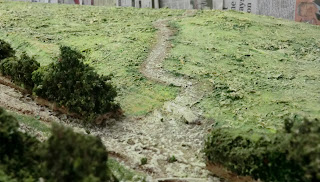When I showed the ponds in the
previous part you will have seen portions of the terrain finished up to that point, so this next sequence of photos gives a general tour round the table, at that stage. Also in this part, I'll show how I tackled the most important feature - the "covered way" that allowed British reinforcements to arrive under cover, and recuperate from their attacks.
 |
| Kevin provided about 50% of the trees. All the ones in the foreground of these two photos are his and are commercially produced (K and M maybe?). He got the thin cypress/poplar trees a few years ago "especially with this game in mind!" |
 |
On the right are Kevin's own very nice scratch built trees.
Standard method of wire armatures twisted to make branches covered with a
compound to resemble bark. Then pieces of, I think, rubberised horsehair
suitably painted and flocked for a leaf effect. We thought they would do a good
job as the North edge of the big woods bordering the garden. Foreground veggie
patches are still lacking greenery. |
 |
Kev's resin haystacks look to me as if they belong in this field. One caught fire
in the historical battle so we were going to allow for that to happen. |
 |
The eastern extremity of our table showing hedges and the Great Orchard.
All these were reclaimed and renovated from our earlier Waterloos. |
 |
Looking along the same stretch of reclaimed road
but due West towards the southern garden wall. |
 |
Junction of Great Orchard with the corner of the Formal Garden. The gate, and
the one below, were old pieces of plastic toy farm fencing with balsa wood gateposts
and cross beam, suitably painted and given some woodgrain effect with fine liner pen. |
 |
Back to the northern perimeter and the pond again. This track leads to the
"covered way" which I had yet to build on the "extra bit" of side terrain. |
 |
The NW corner of the table shows the rising ground to the West
overlooking the kitchen garden.We saw this as the setting for
a French flank attack so I made a battalion-sized open strip
with a hedge for initial cover. |
This next group of photos is of the "extra bit". As I showed in Part 1 another 7 feet x 2 feet section was to go on the side table to form the northern edge of our battlefield, from the "covered way" up the lower slopes of Mont St Jean.
 |
I have rebuilt the LHS "extra bit" with cardboard, PVA and paper, as with the rest.
This photo shows me applying the basic layer of gunge over everything except the track itself |
 |
Basic colour green painted, and the track, plus a small path up the slope, have been
modelled in "yoghurt consistency" filler with PVA and paint, then scribed with wheel
ruts once it had cured to a slightly harder surface |
 |
| You can see it's all rather wet and messy |
 |
The grass has had several dry brushings now, getting steadily lighter and
more yellow while the track gets coloured with a deeper base coat. I just kept on
trying till they were a decent match for the main table. |
Here are some photos of how the "covered way" area looked in 2014. All these views are from the East.
 |
| Hougoumont Farm buildings in the distance were being renovated |
 |
Above and below: still show the bank on the left which made it such a good
sheltered position for the Guard Light infantry to recover. |
The next batch show the finished effect. It was hard to know how far to go with trees for the covered way based on what we had seen first hand, so I decided to make bushy trees for the farm end of the track and very thick hedges on the orchard side but thinner hedges on the MSJ side. In the game we would make anyone sheltering in the covered way out of direct line for artillery and give them hard cover from musketry.
 |
I realised that tall trees at the edge of this board would just be
knocked off by players and get in the way, which is why I opted
for bulky hedges fastened by the drawing pin method
described in the "Making the trees" section of the Waterloo 1
terrain making posts. |
Here it is in action during the game. Kevin's photo shows Nassau infantry, Luneburg light troops and Hanoverian Jagers lining the forward hedge, with British companies reinforcing down MSJ.
That's enough for this part. I'll finish off next time with the Formal Garden and final details.






















This is so beautifully done that it looks good even without the figures!!
ReplyDeleteI totally agree with James, this is indeed splendid!
ReplyDeleteSplendid indeed
ReplyDeleteMost impressive details on your gorgeous terrain!
ReplyDeleteTruly a museum piece (as was La Haye Sainte). What was its ate post-game?
ReplyDeleteBest Regards,
Stokes
Thank you all once again for the nice comments. Stokes, I think you have a typo so I hope I answer correctly. In the game Hougoumont suffered a lot of howitzer fire so various bits of it got ruined and caught fire. Kevin had invested in all the ruined resin bits made by Hovels so when I record the game you will see it falling apart in photographs :-)
ReplyDeleteWonderful post Chris - finding this a fascinating thread mate and the look of your table truly is first class.
ReplyDelete